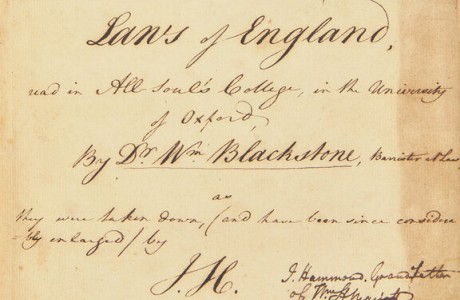Justice as a Sign of the Law: Justice and Punishment
A clear-sighted Justice is at the center of the frontispiece to a 1788 German edition of Cesare Beccaria’s On Crimes and Punishment, first published in 1764. Beccaria was an eighteenth-century Italian jurist, philosopher, and politician. His well-known treatise, condemning torture and the death penalty, remains a foundation for theories of punishment. Beccaria’s premises of reason, utility, and deterrence resulted in his rejection of executions.
Depicted is a Justice turning her eyes away, with scales, entangled with tools used in farming and industry, dangling by her side. She refuses the offering of a severed head by an executioner. Her posture enacts the position adopted today by those seeking to abolish the death penalty. The illustration was based on a sketch drawn by Beccaria himself.

Beccaria, Cesare. Von Verbrechen und Strafen (Breslau: Johann Friedrich Korn, 1788). Lillian Goldman Law Library.
“The Remarkable Run of a Political Icon: Justice as a Sign of the Law” is curated by Judith Resnik, Dennis Curtis, Allison Tait, and Mike Widener, and is on display Sept. 19-Dec. 16, 2011, in the Rare Book Exhibition Gallery, Level L2, Lillian Goldman Law Library, Yale Law School.


